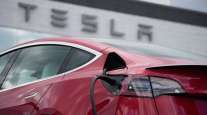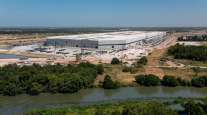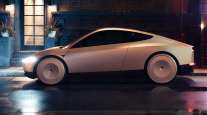Selling a Truck to Detroit’s Loyal Owners May Be Tesla’s Toughest Challenge Yet

A year before Elon Musk was ready to unveil Tesla’s first pickup model, the CEO was setting a low bar for the amount of demand it will draw. Dig into the dynamics of the fiercely competitive and tough-to-crack U.S. truck market, and it’s easy to see why.
Japanese automakers have spent two decades and billions of dollars trying to get in on the big pickup gravy train. But 20 years after Toyota first started making the Tundra, Detroit brands continue to crush the competition, controlling almost 92% of the half-ton truck segment, according to IHS Markit. Customers who own Ram pickups are more loyal than owners of any other model line in the U.S., the researcher says, and Ford and Chevrolet aren’t far behind.
Late Nov. 21, Musk will start his ascent up arguably the toughest hill Tesla has tried to climb yet with the debut of Cybertruck. He cautioned in November of last year that he wasn’t sure if a lot of people will buy the pickup and in June said the design won’t be for everyone. The comments contrast starkly with the bold predictions Musk has made about how many Model 3 sedans and Model Y crossovers his company will manage to sell in the coming years.
Cybertruck unveil Thursday night pic.twitter.com/AHBxaubdhO
— Elon Musk (@elonmusk) November 16, 2019
“An electric pickup truck needs to meet the needs and capabilities of current pickup trucks and deliver a little bit more,” IHS Markit Analyst Stephanie Brinley said. “A traditional pickup-truck buyer may consider electric, but they are not going to give up on capability.”
Detroit automakers aren’t waiting for Musk to take the wraps off his truck before starting to talk a little trash. Thirteen months after the Tesla boss tweeted that his pickup will boast 300,000 pounds of towing capacity, Ford released a video of an electric F-150 prototype dragging 1 million pounds of double-decker railcars.
Ahead of this week’s Los Angeles Auto Show, the vice president of marketing for General Motors’ GMC brand doubted Tesla’s pickup will be in the same league.
“I suspect price-wise there might be some similarities, but I think in terms of size and capabilities, there might be a difference,” GMC’s Phil Brook said. “People who buy our trucks, they are very proud of the fact that they’ll take their trucks anywhere, they’ll get them dirty, then they’ll wash them out and go to a five-star restaurant for dinner. So they’re not people who just drive them around and want to look good.”
Musk told a Tesla enthusiast podcast earlier this year that he wants his truck to start at less than $50,000. Not all of his comments about the pickup have moderated expectations: During an October earnings call, he declared it will be the company’s “best product ever.”
Tesla shares have been on a roll since that quarterly report, surging 42% on optimism the company can produce profits on a more sustainable basis. But it’s unclear how soon the new truck will contribute to those efforts. The Model Y crossover is scheduled to launch next summer, and limited production of the Semi truck is planned for next year. Toni Sacconaghi, an analyst at Sanford C. Bernstein, expects Tesla to begin building the pickup in late 2020 or early 2021.

Rivian vehicle by Patrick T. Fallon/Bloomberg News
Tesla probably won’t have the electric-truck market to itself for long, if at all. Amazon-backed Rivian Automotive plans to launch its R1T pickup late next year. Ford has vowed to start selling hybrid-electric and battery-electric versions of the F-150 starting in 2020, and GM has committed to producing plug-in pickups at a plant it had been planning to shutter in the Detroit area.
Battery prices will have to drop significantly for electric trucks to reach parity with combustion engine-powered pickups, according to Credit Suisse Analyst Dan Levy.
“Given electrification cost constraints and customer preferences, we expect the large-truck segment will be among the last segments to see an inflection in volumes toward electrification,” Levy wrote in a report this week. He assumes Tesla will be selling about 50,000 pickups by 2025, compared with an estimated 300,000 for Model 3 and 400,000 for Model Y.
One obstacle that shouldn’t be overlooked is the tough time Tesla has had operating in truck country. Texas, which bars manufacturers from selling vehicles direct to consumers, is the top state for U.S. registrations of half-ton pickups, according to IHS. The state’s share of the nationwide total this year through September, 14%, is more than double the runner-up, Michigan, which also has a ban.
Tesla’s Nov. 21 event bookends the press days for the Los Angeles Auto Show, where Ford generated buzz with the debut of the Mustang Mach-E electric SUV. But seeking attention of his own wasn’t the only motivation for Musk to stage his truck reveal now and near the show. When announcing the date and locale, he joked on Twitter they were “strangely familiar” and shared a link to the opening credits and scene of the 1982 film “Blade Runner,” which was set in November 2019. He had referenced the movie before as inspiration for the pickup’s futuristic design.
The date is strangely familiar …https://t.co/YZl5R1POJL — Elon Musk (@elonmusk) November 6, 2019
“Musk has indicated it ‘looks like an armored personnel carrier from the future,’ from the set of Blade Runner, and is ‘unrecognizable from the trucks from the past 20-40 years,’ which we think could carry the risk of not attracting traditional pickup buyers, leaving it a lower-volume niche product,” Deutsche Bank Analyst Emmanuel Rosner wrote in a report this week.
Investors will want to know more about production timing, increased capital-spending requirements and where Tesla will build the truck, he said.
With assistance from Keith Naughton.




